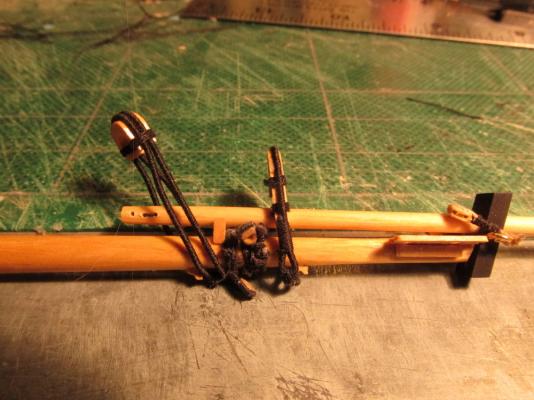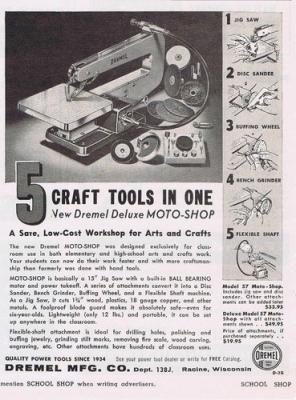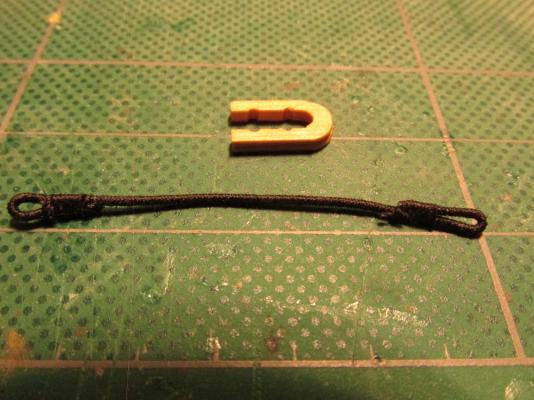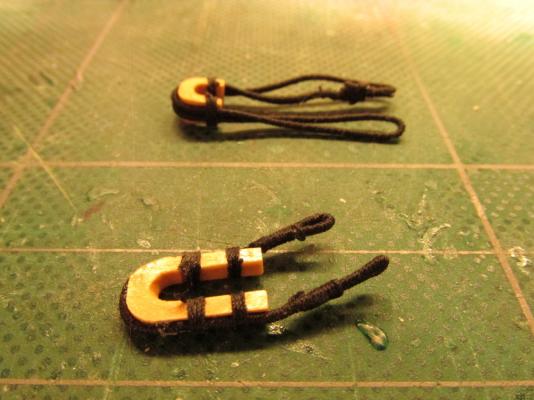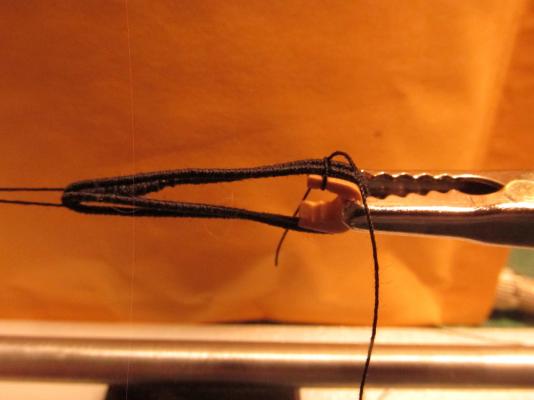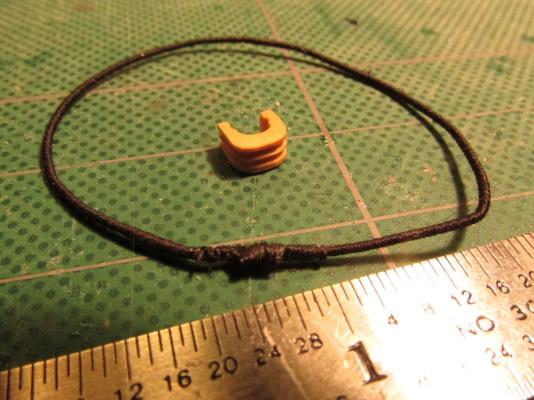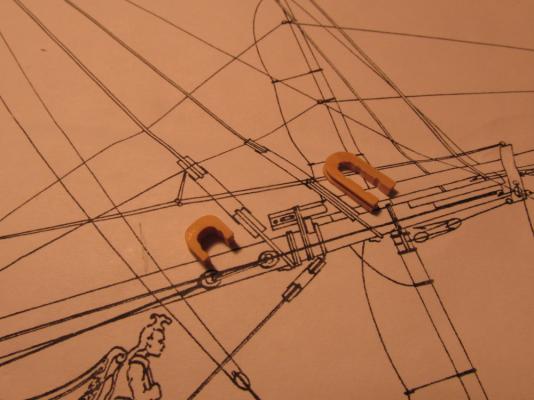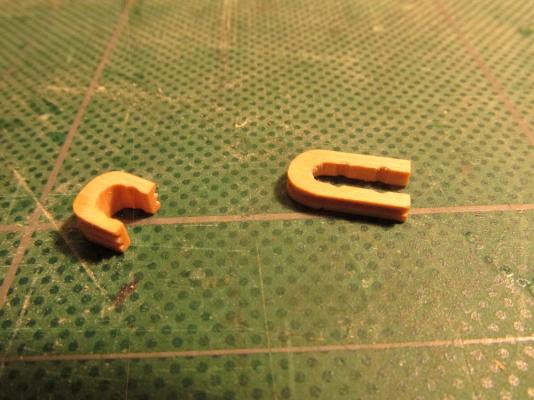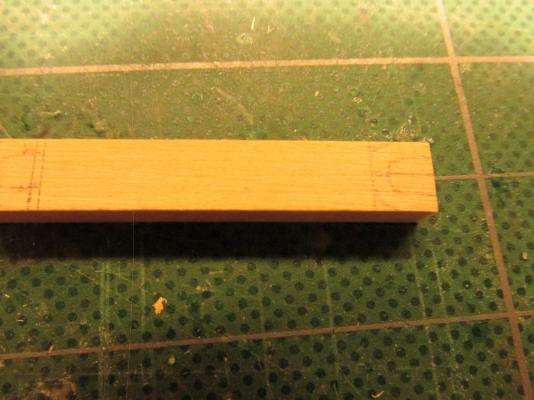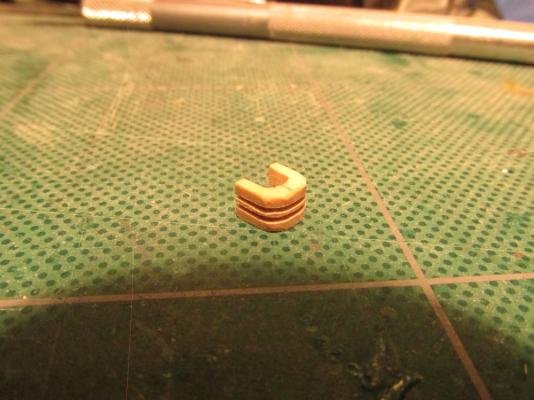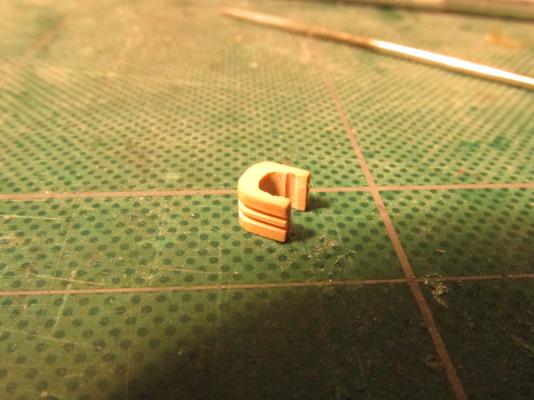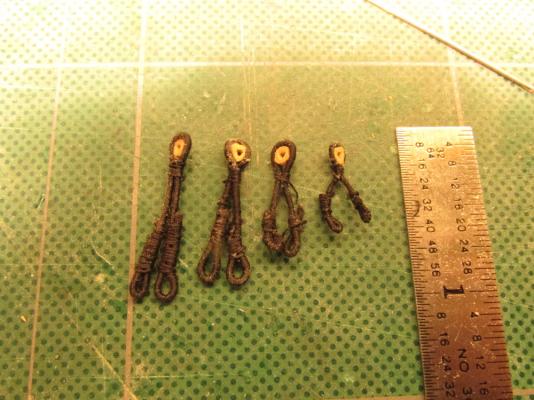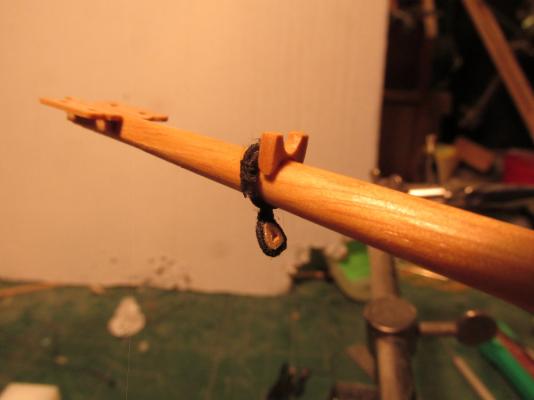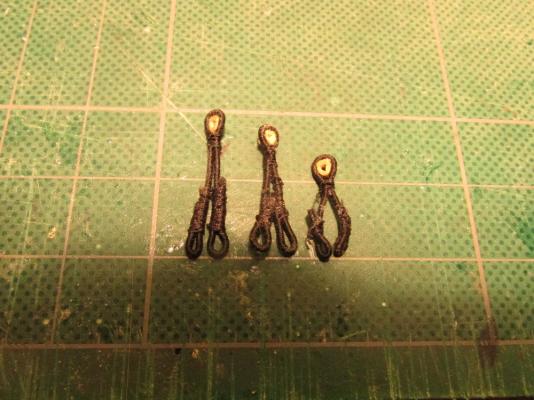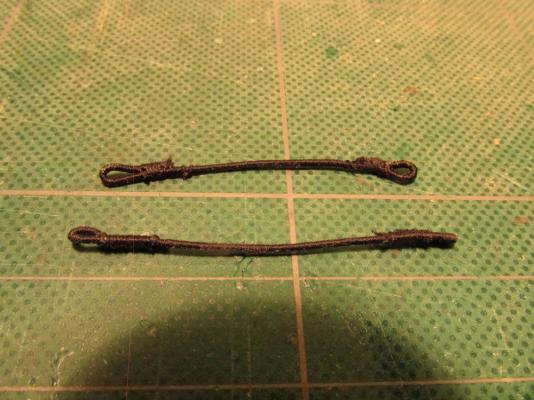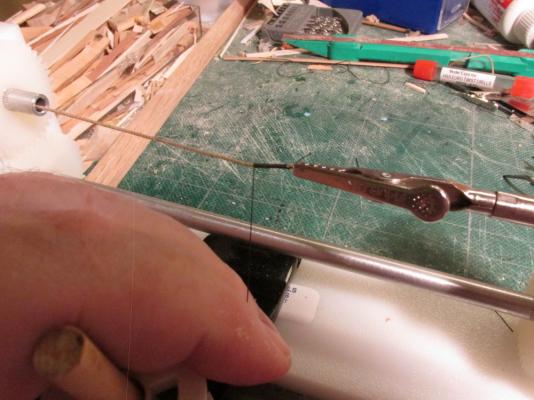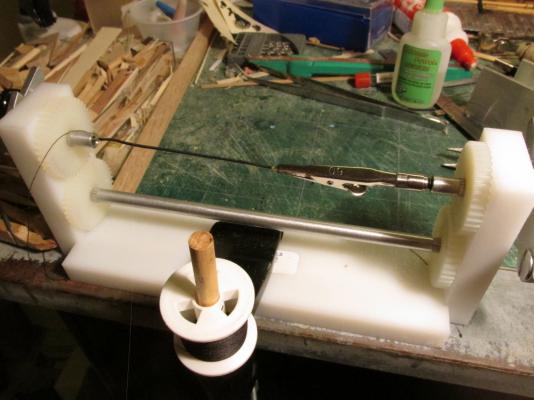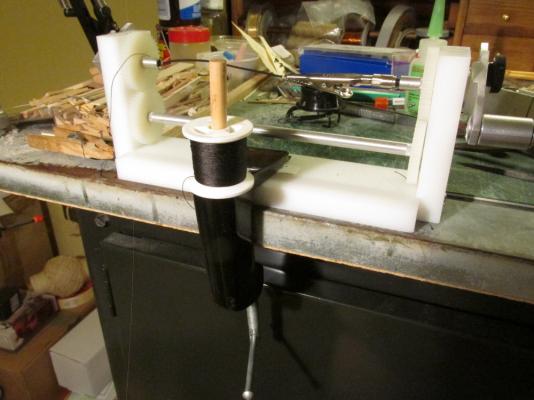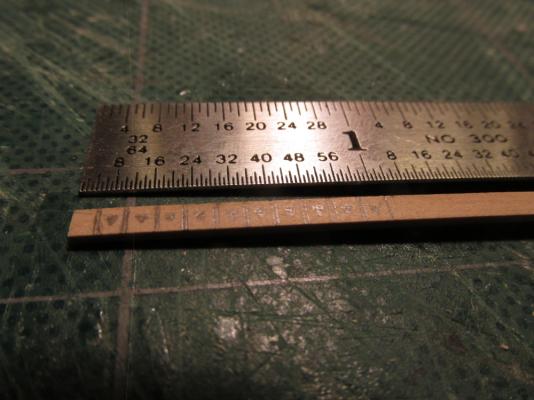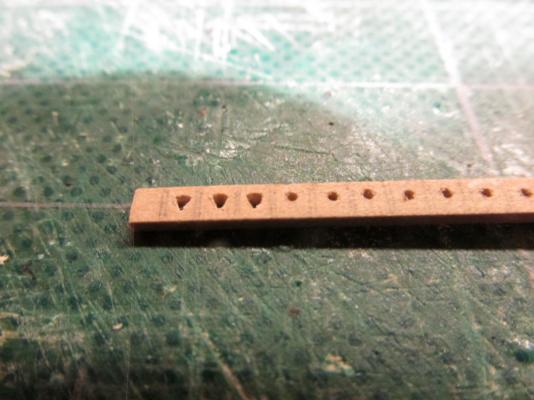-
Posts
2,610 -
Joined
-
Last visited
Content Type
Profiles
Forums
Gallery
Events
Everything posted by JSGerson
-
It was again time to dry fit all the components so far. But before I did that I added some eyelets, made holes for additional future eyelets and added blocks to the installed eyelets on the bowsprit cap. Then I assembled them all together.
- 974 replies
-
- rattlesnake
- mamoli
-
(and 1 more)
Tagged with:
-
There are a number of well made, sturdy 16" scroll saws out there. That's what I'd get, will get in time. It's an invaluable must have tool.
- 974 replies
-
- rattlesnake
- mamoli
-
(and 1 more)
Tagged with:
-
Ken - Funny you should ask about the scroll saw. I have a Dremel Deluxe Moto-Shop 15" scroll saw, with attachments for a flex shaft, and disk sander. I purchased it in the late 70s. It still works as good as the day I got it but that is not saying too much. The problem is that it vibrates like crazy. The disk sander doesn't hold the sanding disks very flat (uses a wide center machine screw), and the flex shaft is not all that smooth in its operation. It's a neat design and should have been perfect for a hobbyist, but it is not a true precision machine. It is what I have so I make do. One of these days I would like to replace it and oh yeah get a mini lathe/milling machine as well when I'm feeling flush...very flush.
- 974 replies
-
- rattlesnake
- mamoli
-
(and 1 more)
Tagged with:
-
They are the same scale, 1:64. The reason I chose the Mamoli kit was that I planned to (am still am) following Robert Hunt's Practicum (some what now) which he based on the Mamoli kit. He claimed you could also use the MS kit with some minor modifications. I started this project in late 2009, so its been 5 years and as you can see, I still have as ways to go. Back then, I knew nothing and I mean NOTHING about building this type of model which was the reason I was following the Practicum. At that time, I didn't even know Model Expo existed! So I went to ebay and found the kit, bid, and won the auction for about $250 (if I remember right). I didn't even comparison shop. I don't know how the two compare quality wise since I have never seen the Model Shipways version. Due to comments on my log and others, I found that a lot of builders purchased just the Model Shipways plans which give you a second way of looking at things. Some details are explained different or better than the other. So I ended up with three set of plans, the two kits plus Harold Hahn's plans which the Practicum uses to supplement the Mamoli kit plans. A lot of the hardware the Mamoli kit provided, I didn't use: I got a replacement wood supply, I scratch built many of the items (cannon carriages, the bittle, lower deck partitions, stern carvings, etc. I don't know what the MS kit provided or didn't. The biggest thing I didn't like about the Mamoli kit was that all of the instructions were printed on the 11 sheets of plans in fine hard to read print. Since I didn't follow those instructions for the most part, it made no difference. If I had to, I would have transcribed them on a word processor and printed them out. Both kits provide certain how-to details and ignore others. The MS kit provides four sheets of plans and booklet of instructions (which you can download). I couldn't of done it without the Practicum. Confused yet? Jon
- 974 replies
-
- rattlesnake
- mamoli
-
(and 1 more)
Tagged with:
-
Ken, as far as I know, there is only one model of the Byrnes Table Saw. There are however two different voltages, I have the 120V for use in the USA as opposed to the 230V. Over the years I have purchased all of the bells and whistles for the saw (different blades, both micrometer stops, fence extensions, and even the tilt table, etc.). I haven't used the tilt table yet for a real project. I have also purchased the draw plate which is invaluable for making tree nails and the dimension sander. I would have purchased the disc sander but I already had one. The Byrnes rope walk is another matter. Until I play with my Model Expo ropewalk to make quality rope and determine it is worth the effort as opposed to buying it from Syren Ship Model Co. which makes top notch rope, that fantastic machine of his is on hold. I would have to have a need from a tremenous amount of miniature rope to justify the cost. As you may surmise, I am a tremendous fan of Jim Brynes and his company. As far as the other subject, the crow's feet, I look forward to rigging that. I am told that it really is not that difficult to make. That's still down the road a bit. I have yet to install any mast, and that rigging is on the third level. Jon
- 974 replies
-
- rattlesnake
- mamoli
-
(and 1 more)
Tagged with:
-
The fore preventer wasn’t measured as it was fitted to the collar. A sufficient length of 0.63mm served line was created. A loop was made at one end and then wrapped around the collar to determine where the second end loop would be constructed and therefore determine the required line length. Once the second end loop was made, the line was again wrapped around the collar and lashed at four points. The double lashing was based on Rigging Period Ship Models by Lennarth Petersson.
- 974 replies
-
- rattlesnake
- mamoli
-
(and 1 more)
Tagged with:
-
The loop was then squeezed together and formed around the collar with the lines in the collar grooves. The line was then lashed to collar at the inner indentations made for that purpose.
- 974 replies
-
- rattlesnake
- mamoli
-
(and 1 more)
Tagged with:
-
Per FFM, the forestay collar strapping was made from 0.63mm served line 128mm leaving unserved line at the ends. The ends were cut diagonally (as best I could) and glued together. I found I had to be generous with CA glue as the ends would come apart just by looking at them. The joint was then seized manually without the use of the seizing machine which can’t work on loops.
- 974 replies
-
- rattlesnake
- mamoli
-
(and 1 more)
Tagged with:
-
- 974 replies
-
- rattlesnake
- mamoli
-
(and 1 more)
Tagged with:
-
A second collar had to be constructed similar to the first for the fore preventer stay. This is the line the crow’s feet attach to and therefore not shown on the Mamoli or Model Shipways plans. Unfortunately this collar is different than what is shown in Antscherl’s book – it is much longer and appears narrower in Hahn’s plans. I took my best shot and winged it. Again the collar had to be the same width as before but almost twice as long. In this case I followed Hahn’s plan and made it with one side groove. It was constructed about ½” long from ¼” x 5/64”
- 974 replies
-
- rattlesnake
- mamoli
-
(and 1 more)
Tagged with:
-
At this point a choice had to be made. Both the Mamoli and ModelShip plans were in agreement with each other but not with Harold Hahn’s plan. Mr. Hahn showed crow’s feet rigging and since I had decided early on to follow the Hahn plans when possible, the crow’s feet were in which affect some of the rigging scheme. Some other details like whether to use deadeyes or hearts on the bowsprit also came into play. From my readings and looking at the various models, it was apparent that there really wasn’t a rigid standard rigging scheme. A lot of the details were at the discretion of the captain and those could change during the course of one cruise. Since I’m the captain of this particular ship I can’t be wrong…mostly…well maybe. I made two more hearts similar to the bobstay to wrap around the bowsprit for the two bowsprit shrouds The forestay has an open heart. Following the guidance of David Antscherl’s The Fully Framed Model, Rigging a Sixth Rate Sloop of 1767 – 1780, Volume IV [FFM], the open heart or the forestay collar as Antscherl calls it. “This is a 13” open heart with a 5” four-strand cabled collar that is doubled,” requires two grooves along the side which will be apparent below. This does not follow Hahn’s plans or at least I think it doesn’t because the only view is from the side and shows one groove. But as I stated before, I’m the captain. The idea of the heart is to allow the jib boom to slide between the forestay lines. Based on that, the 3/16” long heart was made from a piece of ¼” x 1/8” boxwood. The grooves were initially cut with the Byrnes saw and the filed to a semi-circular cross-section.
- 974 replies
-
- rattlesnake
- mamoli
-
(and 1 more)
Tagged with:
-
Glad to have you posting again. You and I are at about the same point in our Rattlesnake builds abet mine is 1:64 scale. Now I'll have you to lead the way once more. I await with high anticipation!
- 41 replies
-
- rattlesnake
- privateer
-
(and 1 more)
Tagged with:
-
If you can't get anymore cannons of the type you want/need, you can always close the gun ports under the fore and aft decks to show what the ship looks like with them closed. Because your decks will be completed (I assume, unlike mine) the viewer will not be able to see below decks very well. I will be too dark and cluttered. I have seen a number of models done this way.
-
When rigging the guns on my Rattlesnake, I was ignorant of making pretty coils of rope. When some commented to me about this I started to look into how to make them. Usually the answer I got was to wrap the rope between two piece of clear plastic disks pieced by a pin or nail. However I did receive this one comment as follows: "I wouldn't bother trying to model those coils like that. They are purely decorative and no sailing ship would have them unless they had visitors coming aboard; Dignitaries, VIPs etc. They tend to keep moisture and rot the deck beneath them if they are left there. They are "yachty" and most sailors wouldn't have them on their boats. I wouldn't." So I didn't change rope coils and saved myself a lot of work in attempting to do them over. Mine look more like a working coil of piled rope. The choice is yours.
- 264 replies
-
- rattlesnake
- model shipways
-
(and 1 more)
Tagged with:
-
Well third time, no wait forth time, no that’s not right, it’s four and a half times is the charm. I made the seized component a third time but this time I reduced the diameter of the rope from 0.8mm to 0.4mm. Remember I initially stated I needed 0.6mm. With the added seizing and the very tight quarters it was to me placed in, I figured I could get away with it, plus the seizing itself added to the diameter of the line. I also tried to shorten the seizing required for the loops and heart. Once more I went to place it on the bowsprit and amazingly it was still too long. This time I undid the seizing on one loop and shorten where the loop started. The loop was re-seized and low and behold it fit!
- 974 replies
-
- rattlesnake
- mamoli
-
(and 1 more)
Tagged with:
-
If I do say so myself, much better!
- 131 replies
-
- rattlesnake
- model shipways
-
(and 1 more)
Tagged with:
-
The component was then folded over in the middle and a heart was glued and then seized at the fold. The idea was that this would wrap around the bowsprit with the heart hanging down as shown in the bowsprit diagram. The two loops would be lashed together at the top as shown to the diagram below. As it turned out both components were too long – the loops over lapped. So I made a third one and guess what? It’s still too long! The good news is I’m getter better at making these things and have noticed that I had too much seizing at the loops and heart. Four hearts down, 6 left. Well back at again. Note: the two diagrams came from: Rigging Period Ship Models by Lennarth Petersson
- 974 replies
-
- rattlesnake
- mamoli
-
(and 1 more)
Tagged with:
-
In case anyone was wondering, my seizing machine came from shipahoymodels.com. The clamp I using to hold it in place is a desk lamp clamp and where the lamp would pivot, I stuck a piece of dowel to hold the spool of thread. It worked quite well. Once the line was seized, it was removed and one end was folded over to create a loop and it was seized again. It was then repeated for the other side. As you can see, two components were made, one smaller than the other. I wasn't sure of the exact length needed.
- 974 replies
-
- rattlesnake
- mamoli
-
(and 1 more)
Tagged with:
-
Next I had to make the stropping that goes around the heart and the bowsprit, which required that I seize the full length of line. The actual line is 1 5/8” f scale or 0.6 mm. The kit provided beige (no black) 0.25 mm, 0.4 mm, 0.8 mm, and 1.2 mm line sizes. I decided to use the 0.8 mm line with black 0.1 mm sewing thread for the seizing. The black thread would completely cover the beige color. Standing rigging was waterproofed with a tar covering and thus black. Using my never before used seizing machine, I proceeded to seize about 3” of line so I would have plenty to work with. First the beige 0.8 mm line was pierced through with the black thread to mechanically secure the thread. The seizing proceeded by cranking the handle of the machine and feeding the black thread through my fingers to keep the line taught. It worked flawlessly.
- 974 replies
-
- rattlesnake
- mamoli
-
(and 1 more)
Tagged with:
-
Once the holes were completed, the individual hearts were cut off from the stock and held with needle nose pliers in order to file the sides to the proper shape. Then, with one of the edges of the triangular needle file, a groove for the rope line was cut around the sides of the heart just like you find on blocks. I only lost one heart when it crumpled in my hands. I filed one of the edges too close to the internal hole. One down, nine hearts left.
- 974 replies
-
- rattlesnake
- mamoli
-
(and 1 more)
Tagged with:
-
Following my plan to attach everything I can to the mast and yards before I install them onto the model, I decided to try my hand at the parts of the bobstay that are attached to the bowsprit. The first thing I needed was a 6” closed heart. Unfortunately none came with the kit and I couldn’t find any on the internet in scale (1:64). I had to make it. Choosing a piece of 1/32” x 3/32” boxwood stock, I sketched out 10 hearts because I really don’t know how many I’ll need in the course of the build. A hole was drilled and then filed into a triangular hole with triangular needle files.
- 974 replies
-
- rattlesnake
- mamoli
-
(and 1 more)
Tagged with:
-
I purchased the MS plans as well as Harold Hahn's plans, and of course I have the Mamoli plans. Each one shows certain details better (or different) than the others. I also downloaded the MS instructions. You never have too much information (unless it's all contradictory). The MS plans show the gap very clearly but does not depict the planking of the transom. Think about how the shipwrights of the day would have made the stern. They didn't have large sheets of plywood so they had to have planked it. I'm following a Practicum by Robert Hunt (LauckStreetShipyard.com). He provides a detailed set of instructions to either build the kit straight out of the box or kitbash it. Although the Practicum is based on the Mamoli kit, he claims it should work for the MS kit as well. Now the Practicum is not perfect and even less so beginning in the last chapter before the rigging starts, but I couldn't have done what I did with out it. The Mamoli instructions are printed directly on the plans in multiple languages and are hard to read especially with my eyesight. So I read the books, look at other people logs, ask questions, and learn from my mistakes...and I have made a lot of them. Your model is showing off your great skills. I have yet to see two models of Rattlesnake that look the same. So who is to say which one is right?
- 131 replies
-
- rattlesnake
- model shipways
-
(and 1 more)
Tagged with:
-
As near as I could determine, the "gap" is suppose to be there. You can see from my build the space between the ornamental carved arch and the transom. This is what I have seen in all the models I have looked at. It just makes the stern look bigger and it appears on a lot of other period ships. Be that as it may, this is your interpretation ship. Since there are no physical remains of the actual ship left, your vision of what it might look like is as good as anyone else.. BTW I like your idea of using the kit supplied arch as a template to make the carvings. This was my first attempt at carving so the results were more impressionistic than a true representative of the actual art work. From a slight distance it seems to work.
- 131 replies
-
- rattlesnake
- model shipways
-
(and 1 more)
Tagged with:
-
I too have a Proxxon XY table on a Dremel drill press and am not so happy. The XY table is fine but a bit of a pain to align on the drill press. The real problem is the drill press itself - it just isn't sturdy enough. I can't tell how many times I've lined up the drill only to have it move laterally when lowing the drill assembly due to the press's low precision. It's made of plastic parts with low tolerances. Hopefully in the near future I will have a true dedicated drill press that can be adjusted with precision. It's just a question of time and money. Isn't it always?
- 335 replies
-
- Constitution
- Mamoli
-
(and 3 more)
Tagged with:
-
Excellent! I think you did much better than I did on our first builds. It looks nice and clean.
- 131 replies
-
- rattlesnake
- model shipways
-
(and 1 more)
Tagged with:
About us
Modelshipworld - Advancing Ship Modeling through Research
SSL Secured
Your security is important for us so this Website is SSL-Secured
NRG Mailing Address
Nautical Research Guild
237 South Lincoln Street
Westmont IL, 60559-1917
Model Ship World ® and the MSW logo are Registered Trademarks, and belong to the Nautical Research Guild (United States Patent and Trademark Office: No. 6,929,264 & No. 6,929,274, registered Dec. 20, 2022)
Helpful Links
About the NRG
If you enjoy building ship models that are historically accurate as well as beautiful, then The Nautical Research Guild (NRG) is just right for you.
The Guild is a non-profit educational organization whose mission is to “Advance Ship Modeling Through Research”. We provide support to our members in their efforts to raise the quality of their model ships.
The Nautical Research Guild has published our world-renowned quarterly magazine, The Nautical Research Journal, since 1955. The pages of the Journal are full of articles by accomplished ship modelers who show you how they create those exquisite details on their models, and by maritime historians who show you the correct details to build. The Journal is available in both print and digital editions. Go to the NRG web site (www.thenrg.org) to download a complimentary digital copy of the Journal. The NRG also publishes plan sets, books and compilations of back issues of the Journal and the former Ships in Scale and Model Ship Builder magazines.



